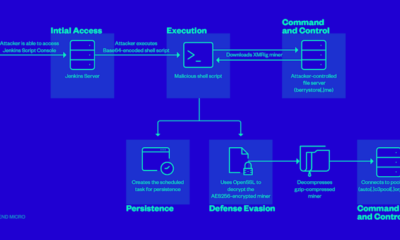News
Crypto Crime Trends of 2024 from Chainalysis
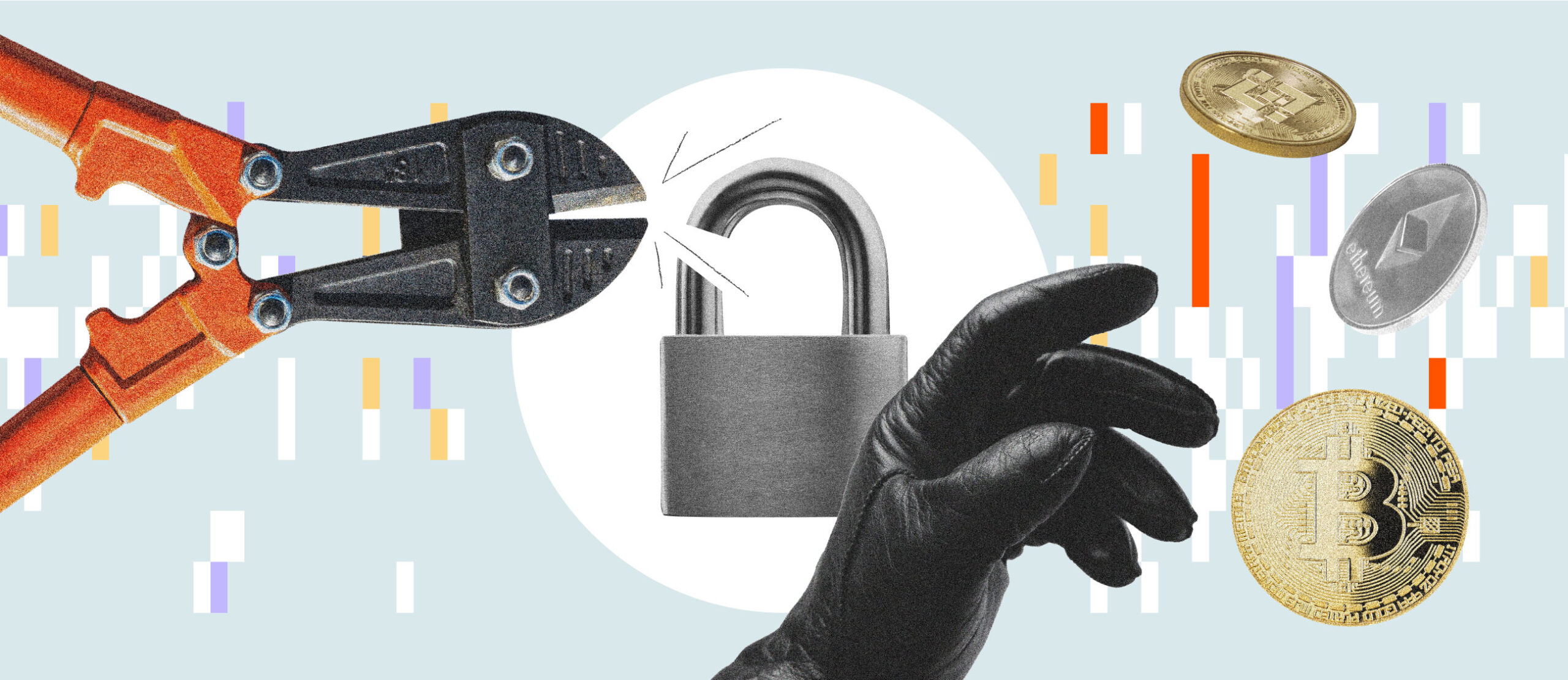
2023 was a recovery year for cryptocurrencies, as the industry recovered from the scandals, explosions, and price drops of 2022. As cryptocurrencies recover and market activity grows throughout 2023, many they believe that the cryptocurrency winter is ending and that a new growth phase could soon be upon us.
But what has all this meant for crypto crime? Let’s take a look at the high-level trends.
2023 saw a significant drop in the value received from illicit cryptocurrency addresses, totaling $24.2 billion. As always, we must point out that these figures are lower estimates based on the inflows to the illicit addresses we have identified today. A year from now, these totals will almost certainly be higher, as we identify more illicit addresses and incorporate their historical activity into our estimates. For example, when we released our Crypto Crime Report last year, we estimated $20.6 billion worth of illicit transaction volume for 2022. One year later, our updated estimate for 2022 is 39 .6 billion dollars. Much of this growth came from identifying previously unknown and highly active addresses hosted by sanctioned services, as well as our addition of transaction volume associated with services in sanctioned jurisdictions to our illicit totals.
Another key reason the new total is much higher, beyond identifying new illicit addresses: We now count $8.7 billion in claims against FTX in our 2022 data. In last year’s report, we had stated that we would withhold inclusion in our illicit totals of transaction volumes associated with FTX and other companies that failed that year under allegedly fraudulent circumstances until legal proceedings arose. Since then, a jury has convicted the former CEO of FTX of fraud.
Typically, we only include measurable on-chain activity in our estimates for illicit activity. In the case of FTX, it is impossible to use on-chain data alone to measure the extent of fraudulent activity, as there is no way to isolate illegitimate movements of user funds. As such, we believe that $8.7 billion in claims from creditors versus FTX is the best estimate to include. Given the size and impact of the FTX situation, we are treating it as an exception to our usual on-chain methodology. If courts convict in similar ongoing cases, we plan to include their activity in our illicit transaction data in the future.
All other totals exclude revenue from non-cryptocurrency crime, such as conventional drug trafficking where cryptocurrencies are used as a means of payment. Such transactions are virtually indistinguishable from legitimate transactions in on-chain data. Of course, law enforcement with off-chain context can still investigate these flows using Chainalysis solutions. In cases where we are able to confirm such information, we consider the transactions to be illicit in our data, but there are almost certainly many cases where this is not the case, and therefore the numbers would not be reflected in our totals.
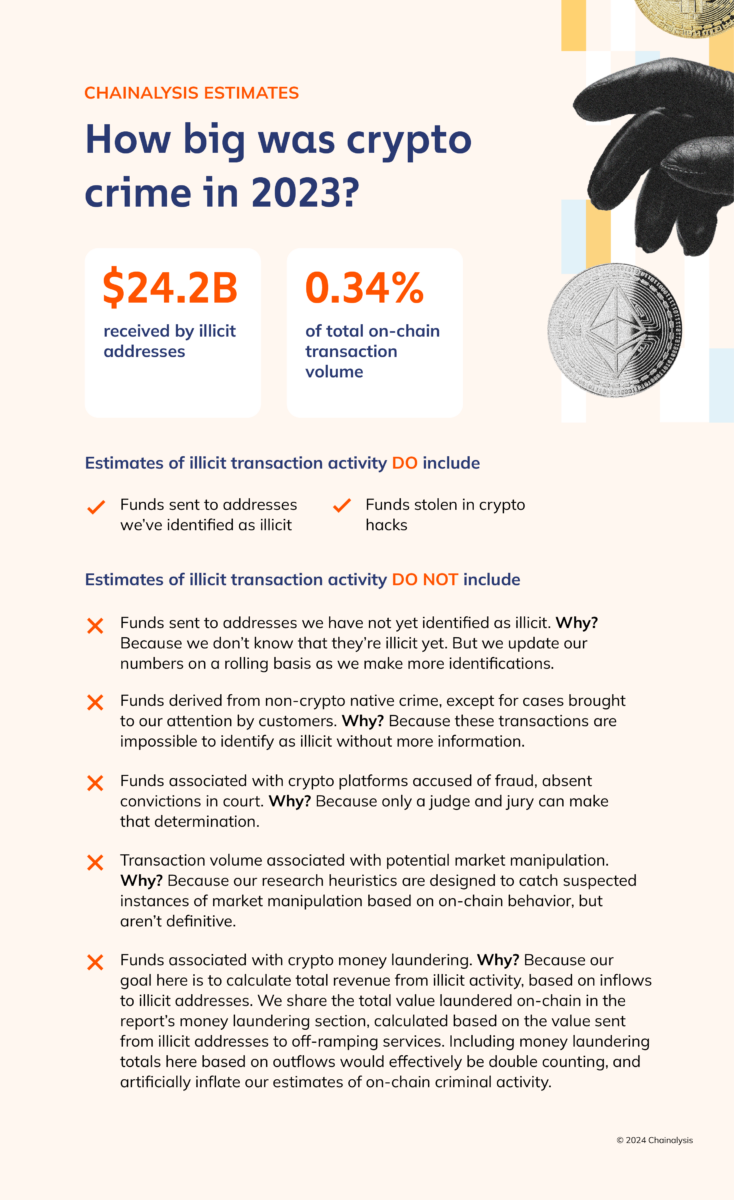
In addition to the reduction in the absolute value of illicit activity, our estimate for the share of all crypto transaction volume associated with illicit activity also fell, to 0.34% from 0.42% in 2022. [1]
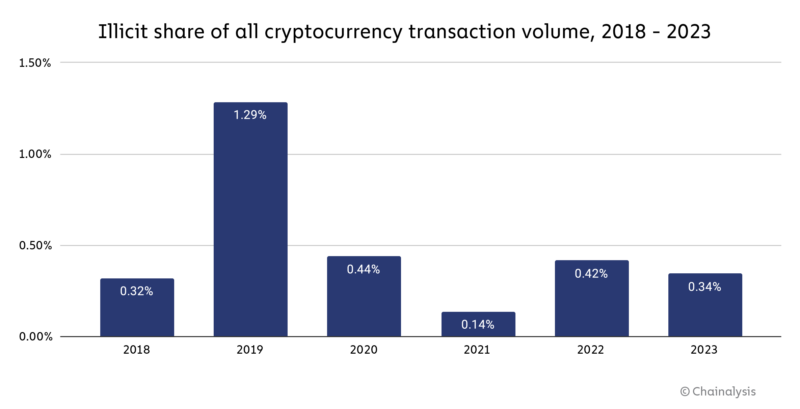
We are also seeing a shift in the types of assets involved in cryptocurrency-based crime.
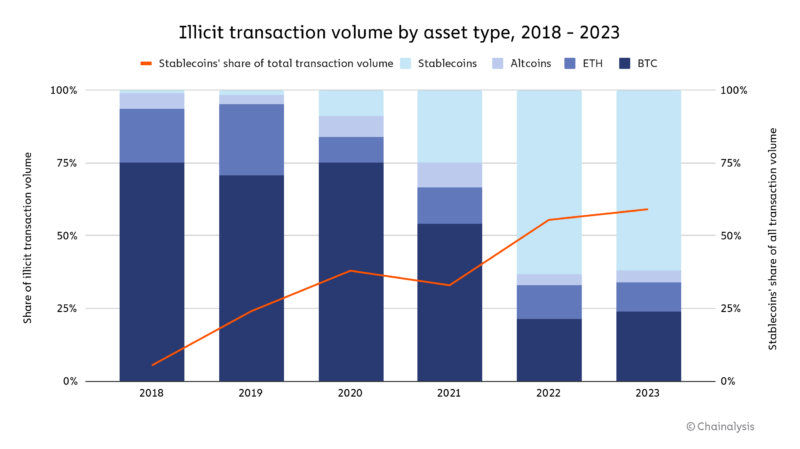
Until 2021, Bitcoin reigned supreme as the cryptocurrency of choice for cybercriminals, likely due to its high liquidity. But things have changed in the last two years, with stablecoins now accounting for the majority of illicit transaction volume. This change also comes with it recent growth in stablecoins’ share of all overall crypto assets, including legitimate assets. However, the dominance of stablecoins is not the case for all forms of cryptocurrency-based crime.
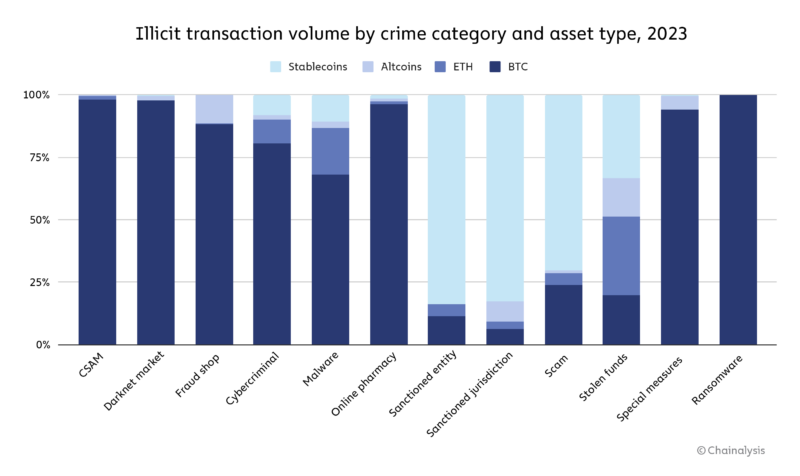
Some forms of illicit cryptocurrency activity, such as darknet marketplace sales and ransomware extortion, still occur predominantly in Bitcoin. [2] Others, such as scams and transactions associated with sanctioned entities, have moved to stablecoins. These are also the largest forms of crypto crime in terms of transaction volume, thus driving the larger trend. Sanctioned entities, as well as those operating in sanctioned jurisdictions or involved in terrorist financing, also have a greater incentive to use stablecoins, as they may face greater challenges in accessing the US dollar through traditional means, but still want to benefit from the stability that provides. . However, stablecoin issuers can freeze funds when they become aware of their illicit use, like Tether done recently with addresses linked to terrorism and the war in Israel and Ukraine.
Below, we will look at three key trends that have defined crypto crime in 2023 and that will be important to watch moving forward.
Scams and stolen funds decrease significantly
Revenue from scams and hacking declined significantly in 2023, with total illicit revenue down 29.2% and 54.3%, respectively.
As we will discuss later in our scams section, many cryptocurrency scammers have now adopted romance scam tactics, targeting individuals and building relationships with them to pitch them to fraudulent investment opportunities, rather than advertising them far and wide, which it often makes them harder to discover. Even if the FBI did published data showing While reports of cryptocurrency investment scams in the US have increased year-over-year through 2022, our on-chain metrics suggest that scam revenues globally have been on a downward trend since 2021. We believe this is in line with the long-standing trend that scams are most successful when markets are rising, exuberance is high and people feel like they are missing out on an opportunity to get rich quick. Of course, the impact of romance scams on individual victims is devastating and should not be underestimated. And while the increase in reports – at least in the United States – is a good sign, we still believe that insights into romance scams in particular suffer from underreporting. We hypothesize that the true damage from scams is greater than what FBI reports and our on-chain metrics show, but overall, scams are declining, given broader market dynamics.
Crypto hacking, on the other hand, is much harder for criminals to hide, as industry observers can quickly spot unusual outflows from a given service or protocol when a hack occurs. As we will discuss later, the decline in stolen funds is driven largely by a sharp decline in DeFi hacking. This abandonment could represent the reversal of a disturbing situation, long-term trendand it could mean that DeFi protocols are improving their security practices. That said, stolen funds metrics are heavily driven by outliers, and a major hack could change the trend again.
Ransomware and darknet market activity is on the rise
Ransomware and darknet markets, on the other hand, are two of the most prominent forms of cryptocrime that saw revenue increase in 2023, bucking overall trends. Ransomware revenue growth is disappointing following the sharp decline seen in our country covered last yearand suggests that perhaps ransomware attackers have adapted to improvements in organizations’ cybersecurity, a trend we first reported Before this year.
Likewise, this year’s growth in darknet market revenues also comes after a 2022 decline in revenue. This decline was caused largely by the shutdown of Hydra, which was once by far the most dominant market in the world, capturing over 90% of all darknet market revenue at its peak. While no single market has yet emerged to take its place, the sector as a whole is on the rebound, with total revenue returning towards 2021 highs.
Transactions with sanctioned entities underlie the vast majority of illicit activities
Perhaps the most obvious trend that emerges when looking at the volume of illicit transactions is the importance of sanctions-related transactions. The sanctioned entities and jurisdictions together accounted for a combined $14.9 billion in transaction volume in 2023, representing 61.5% of all illicit transaction volume we measured during the year. The majority of this total is driven by cryptocurrency services that have been sanctioned by the U.S. Treasury Department’s Office of Foreign Assets Control (OFAC), or that are located in sanctioned jurisdictions and that can continue to operate because they are located in jurisdictions where US sanctions are in effect. not applied.
While such services can and have been used for nefarious purposes, this also means that some of that $14.9 billion in sanctions-related transaction volume includes activity from average cryptocurrency users residing in those jurisdictions. For example, the Russian stock exchange Garantex, which was sanctioned by OFAC AND OFSI in the UK. for facilitating money laundering on behalf of ransomware attackers and other cyber criminals, was a major driver of transaction volume associated with sanctioned entities in 2023. Garantex continues to operate because Russia does not enforce US sanctions. So does this mean that all of Garantex’s transaction volume is associated with ransomware and money laundering? No. However, Garantex exposure introduces serious sanctions risks for crypto platforms under US or UK jurisdiction, meaning that such platforms must remain increasingly vigilant and monitor Garantex exposure to be compliant .
More insights into crypto crime to come
Stay up to date on more research into cryptocurrency crime as we continue to provide insights into ransomware, hacking, crypto money laundering and more. You can too Click here to receive the entire 2024 Crypto Crime Report directly to your inbox as soon as it is published.
Final notes:
[1] Transaction volume is a measure of all economic activity, an indicator of how funds change hands. We eliminate peeling chains, internal service transactions, switching, and any other type of transaction that would not count as an economic transaction between distinct economic actors.
[2] These estimates do not include privacy coins like Monero.
This material is for informational purposes only and is not intended to provide legal, tax, financial, investment, regulatory or other advice, nor should it be relied upon as professional advice. Recipients should consult their own advisors before making these types of decisions. Chainalysis does not guarantee the accuracy, completeness, timeliness, suitability or validity of the information contained herein. Chainalysis has no liability for any decision made or any other act or omission in connection with Recipient’s use of this material.
News
US Cryptocurrency Rules Delayed by ‘Never-Ending’ Lawsuits

Ripple CEO says cryptocurrency industry still seeking regulatory clarity from US
Speaking to Bloomberg News on Wednesday (July 17), Author: Brad Garlinghouse he said America is behind behind other countries which have already adopted cryptocurrency regulations.
“What we’re seeing, where it’s the UK, Japan, Singapore… even the European Union, more than two dozen countries have come together to provide a framework for cryptocurrency regulation,” Garlinghouse said.
“It’s frustrating that we as a country can’t get that regulatory framework in place. And instead, we have this never-ending lawsuit coming from the SEC that doesn’t really address the problem.”
Ripple has been the target of some of these legal disputes. Securities and Exchange Commission (SEC) sued the company in 2020, accusing it of conducting a $1.3 billion operation offering of unregistered securities tied to its XRP token.
However, last year a judge ruled that only Ripple’s institutional sales of XRP, not retail sales, violated the law, a decision widely seen as a victory for the cryptocurrency industry.
As PYMNTS noted at the time, that ruling has “far-reaching repercussions impact across the digital asset ecosystem, which has long maintained that its tokens do not represent securities contracts.”
However, Garlinghouse told Bloomberg on Wednesday that the company cannot wage multimillion-dollar legal battles over each token.
He spoke to the news agency from the Republican National Convention in Milwaukee, where the party is backing the candidacies of former President Donald Trump and Ohio Sen. J.D. Vance, both of whom are considered pro-cryptocurrency.
But Garlinghouse argued that cryptocurrencies “should not be a partisan issue,” and noted that he had recently attended a conference in Washington that included Democrats, including White House officials.
“I think they were there, listening to the industry… it was refreshing to start having that conversation,” she said.
President Joe Biden earlier this year he vetoed a measure which would have ended the SEC’s special rules for crypto-asset custodians. This legislation was supported by both the digital asset industry and the banking industry.
Ripple early this year donated $25 million to the cryptocurrency industry’s super PAC Fair Smoothiewith Garlinghouse stating at the time that such donations would continue every year, as long as the industry had its detractors.
Second Open SecretsWhich monitor spending For campaigns, the PAC has spent $13.4 million this year, much of it to help defeat Rep. Katie Porter’s (D-Calif.) U.S. Senate campaign.
News
The Future of Cybersecurity in the Cryptocurrency Industry

The cryptocurrency space has had a tumultuous journey, with its fair share of ups and downs. As we look to the future, one area that remains a constant focus is cybersecurity. The digital nature of cryptocurrencies makes them inherently vulnerable to cyber threats, and as the industry evolves, so does the landscape of potential risks.
In 2022, the cryptocurrency market faced significant challenges, with over $2 trillion in market value lost. This event served as a wake-up call for the industry, highlighting the need for robust cybersecurity measures. The future of cryptocurrency security is expected to see a shift towards more regulated and established institutions taking the reins of crypto technology and blockchain infrastructure.
The decentralized nature of cryptocurrencies offers numerous benefits, such as transparency and financial inclusion. However, it also introduces unique security challenges. The risk landscape is filled with threats such as hacking, phishing, ransomware attacks, malware, and social engineering. These threats not only lead to financial losses, but also damage the reputation and trust within the cryptocurrency ecosystem.
Mini-MBA Tekedia edition 15 ((September 9 – December 7, 2024) started recordings; Register today for discounts reserved for early bird customers.
Tekedia AI in Business Masterclass Opens registrations Here.
Join the Tekedia Capital Syndicate and IInvest in Africa’s best startups Here.
The decentralized nature of cryptocurrencies offers many benefits, but it also presents unique security challenges. Cyber risks such as hacking, phishing, and ransomware pose threats to the integrity of digital assets. The infrastructure that supports cryptocurrencies is not immune to vulnerabilities, including smart contract flaws and exchange hacks.
To address these vulnerabilities, the infrastructure that supports cryptocurrencies must be strengthened. Smart contract vulnerabilities, exchange hacks, wallet breaches, and flaws in the underlying blockchain technology are significant concerns that must be addressed to ensure the security and integrity of digital assets.
As cybercriminal tactics and techniques become more sophisticated, the cryptocurrency industry must stay ahead of the curve. The future will likely see more targeted attacks, exploiting weaknesses in infrastructure, networks, and human factors. This requires a proactive and multifaceted approach to cybersecurity.
To mitigate these risks, several measures must be adopted:
Strengthening security measures: Developers, exchanges, and wallet providers must improve security protocols, use strong encryption, implement multi-factor authentication, and conduct regular security audits.
Education and awareness: Users should be educated on best practices for protecting their digital assets, including using strong passwords, recognizing phishing attempts, and using hardware wallets for secure storage.
Looking ahead, the cryptocurrency industry is expected to see an increased focus on robust security measures. Blockchain projects and exchanges are likely to invest in advanced encryption techniques and decentralized storage solutions to protect user assets. The future impact of cyber risk on cryptocurrencies will depend on the collective efforts of stakeholders to address vulnerabilities and strengthen security measures.
Collective efforts by stakeholders in the cryptocurrency space are crucial to address vulnerabilities and strengthen security measures. While challenges persist, advances in cybersecurity technologies and practices offer hope for a more secure and resilient cryptocurrency ecosystem.
The future of cybersecurity in the cryptocurrency industry depends on finding a balance between innovation and regulation. It requires a collaborative effort from all parties involved, from developers to end users, to create a secure environment that fosters trust and growth in the industry. As we move forward, it is critical that lessons learned from past events guide the development of stronger security measures, ensuring the longevity and stability of cryptocurrencies as a vital part of the modern economic toolkit.
Like this:
Like Loading…
News
Bullish XRP and RLBK price predictions rise, outpacing the broader cryptocurrency market, prompting Shiba Inu holders to switch!

Bitcoin’s one-week surge from $60,000 has pushed other cryptocurrencies into an uptrend. However, for many altcoins, this trend has been temporary. Altcoins such as XRP and Shiba Inu (SHIB) have experienced price drops. However, Rollblock, a new altcoin on the Ethereum blockchain, has thrived during this period, attracting thousands of investors looking for long-term growth.
XRP’s Nearly 30% Growth Over Last Week Drops as Selling Pressure Increases
XRP is seeing further price decline as Ripple investors withdraw their profits from the token. The surge in XRP’s price to $0.64 in the past week has provided investors with a perfect opportunity to increase their returns in the short term. With the ongoing sell-off in XRP, XRP has jumped over 8% in the past day and is now trading at $0.59. However, analysts tracking XRP indicators predict that XRP could still extend its gains by over 30% in the coming weeks.
Shiba Inu (SHIB) marks its third consecutive day of losses
Shiba Inu (SHIB) is in a period of adjustment after a week of strong gains. In the last 24 hours, SHIB has seen a jump of over 7%, reflecting a natural market fluctuation. Analysts are observing a death cross on the Shiba Inu chart, which historically signals the potential for future opportunities as the market stabilizes. As investors explore new possibilities, some are diversifying into promising altcoins like Rollblock (RBLK) to strategically rebalance their portfolios and capitalize on the emerging trend.
Rollblock (RBLK) Up Another 7% as New Investors Join Pre-Sale
Rollblock (RBLK) has taken the cryptocurrency market by storm, having attracted investors from more popular altcoins like Shiba Inu (SHIB) and XRP. Rollblock’s growth is attributed to its utility in the $450 billion global gaming industry.
Rollblock aims to use blockchain technology to bridge the gap between centralized and decentralized gambling. With blockchain technology, Rollblock secures every transaction in its online casino, providing transparency and convenience to millions of players who are uncomfortable placing bets on other iGaming platforms.
This innovative use of blockchain technology in the industry has grown Rollblock to over 4,000 new users in less than two months. With plans to add sports betting, this number is expected to grow exponentially in Q3.
Rollblock uses a revenue sharing model that splits up to 30% of its casino’s weekly profits with token holders. This happens after Rollblock buys back $RBLK from the open market and uses half of it for rewards. The other half is burned to increase the price of $RBLK.
Rollblock price has seen four increases in the past month with $RBLK tokens now selling for $0.017. Analysts predict that at the current growth rate, Rollblock could increase by over 800% before the presale ends. For investors looking for a long-term token with growth potential, phase four is the best time to buy Rollblock before its price skyrockets!
Discover the exciting Rollblock (RBLK) pre-sale opportunities now!
Website:https://Rollblockpresale.io/
Social: https://linktr.ee/Rollblockcasino
No spam, no lies, just insights. You can unsubscribe at any time.
News
Texas Crypto Miners Turn to AI as Crypto Declines

As cryptocurrency mining becomes less profitable, Texas cryptocurrency mining companies are switching to supporting artificial intelligence companies.
Bitcoin miners, with their sprawling data centers and access to significant energy resources, are ideally suited for computationally intensive AI operations, and as cryptocurrency mining becomes less profitable, companies see this shift as a logical answer to their problems.
On Thursday, Houston-based Lancium and Denver-based Crusoe Energy Systems announced a multibillion-dollar deal to build a 200-megawatt data center near the West Texas city of Abilene to support advanced artificial intelligence applications such as medical research and aircraft design, CNBC reported. The plant represents the first phase of a larger 1.2 gigawatt project.
Lancium and Crusoe’s move into AI mirrors a broader trend among bitcoin miners. The combined market capitalization of the top U.S.-listed bitcoin miners hit a record $22.8 billion in June. Companies like Bit Digital and Hut 8 are diversifying into AI, with Bit Digital securing a $92 million annual revenue deal to supply Nvidia GPUs and Hut 8 raising $150 million to expand its AI data center.
But the growing popularity of these operations also presents challenges, particularly for the Texas power grid. Last month, the Electric Reliability Council of Texas announced that the state is expected to nearly double its energy production by 2030 to meet the high energy demands of data centers and cryptocurrency operations.
Lieutenant Governor Dan Patrick expressed concern about the projections.
“Cryptocurrency miners and data centers will account for more than 50% of the additional growth. We need to take a close look at these two sectors,” He wrote on Twitter/X. “They produce very few jobs compared to the incredible demands they place on our network. Cryptocurrency miners could actually make more money selling electricity to the network than they do from their cryptocurrency mining operations.”
Analysts predict significant growth in data center power capacity, which is expected to account for up to 9% of U.S. electricity consumption by 2030.
The operations also pose challenges for nearby cities. Earlier this month, TIME reported that a crypto-mining facility was seriously compromising the health of residents in the city of Granbury. TIME reported more than 40 people with serious health problems, including cardiovascular disease, high blood pressure and hearing loss. At least 10 of the residents needed to go to the emergency room or an urgent care facility.
The disturbances were caused by the extreme noise generated by the crypto-mining facility’s fans, which are used to keep the machines cool. While the proposed data center in Abilene would use liquid cooling systems, it’s still unclear whether the facility’s operations would pose a health risk to local residents.
-

 Nfts1 year ago
Nfts1 year agoShardLab Launches ZK-Based Tool for Digital Identity and NFT Vouchers
-

 News1 year ago
News1 year agoWallet recovery firms are abuzz as stranded cryptocurrency investors panic in the bitcoin boom
-

 Bitcoin1 year ago
Bitcoin1 year agoBitcoin, Ethereum, Solana and Cryptocurrency Markets Look Ready to ‘Send’ as Stars Align, According to Investor Chris Burniske
-

 Altcoins12 months ago
Altcoins12 months agoThree Altcoins Poised for Significant Growth in 2024: ETFS, OP, BLAST
-

 Altcoins12 months ago
Altcoins12 months agoAccumulate these altcoins now for maximum gains
-

 Nfts1 year ago
Nfts1 year agoOG Crypto Artist Trevor Jones Unveils Groundbreaking Collection of Ordinals | NFT CULTURE | NFT News | Web3 Culture
-

 Bitcoin1 year ago
Bitcoin1 year agoBillionaires are selling Nvidia stock and buying an index fund that could rise as much as 5,655%, according to some Wall Street analysts
-

 Videos9 months ago
Videos9 months agoKamala just won the boner! [Bad For Crypto]
-

 Videos1 year ago
Videos1 year agoLIVE FOMC 🚨 Could be CATASTROPHIC for Altcoins!
-

 News1 year ago
News1 year agoA Guide for Newcomers & Beginners – Forbes Advisor
-

 Videos1 year ago
Videos1 year agoAttention: a historically significant BITCOIN signal has just appeared!
-

 Videos1 year ago
Videos1 year agoSTOCK MARKET FUD! ⚠️ [Why This Is GREAT For Bitcoin Traders!]











